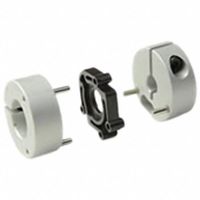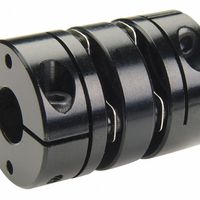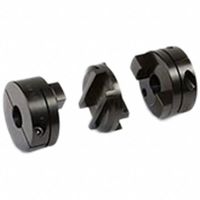Call +(254) 703 030 000 / 751 483 999 / 721 704 777
- Home
- Power Transmission
- Shaft Couplings Universal Joints
- Precision Motion Control Couplings
.....Read More
Frequently Asked Questions
What are the advantages of beam shaft couplings?
Beam shaft couplings, also known as helical couplings, offer several advantages in mechanical systems:
1. **Flexibility**: Beam couplings are designed with a helical cut pattern that allows them to accommodate angular misalignment, parallel misalignment, and axial motion. This flexibility helps in maintaining the alignment of connected shafts, reducing stress on the system.
2. **Torsional Stiffness**: Despite their flexibility, beam couplings provide good torsional stiffness, which ensures efficient torque transmission between shafts. This balance between flexibility and stiffness is crucial for precision applications.
3. **Vibration Damping**: The design of beam couplings allows them to absorb and dampen vibrations, which can protect sensitive components and improve the longevity of the system.
4. **Compact Design**: Beam couplings are typically compact and lightweight, making them suitable for applications with space constraints. Their simple design also facilitates easy installation and maintenance.
5. **No Lubrication Required**: Beam couplings are generally maintenance-free and do not require lubrication, which reduces the overall maintenance cost and effort.
6. **Corrosion Resistance**: Often made from materials like stainless steel or aluminum, beam couplings offer good resistance to corrosion, making them suitable for use in harsh environments.
7. **Versatility**: They are available in various sizes and configurations, allowing them to be used in a wide range of applications, from small precision instruments to larger industrial machinery.
8. **Cost-Effective**: Beam couplings are generally cost-effective compared to other types of flexible couplings, providing a good balance of performance and price.
These advantages make beam shaft couplings a popular choice in applications requiring precision, reliability, and flexibility.
How do slit couplings handle high torsional loads?
Slit couplings handle high torsional loads by utilizing their unique design, which incorporates a series of slits cut into a cylindrical piece of material, typically metal. These slits create a flexible structure that can accommodate misalignments and absorb torsional forces. The flexibility provided by the slits allows the coupling to twist slightly, distributing the torsional load more evenly across the entire coupling. This reduces stress concentrations that could lead to failure.
The material used for slit couplings is often chosen for its strength and fatigue resistance, ensuring that it can withstand repeated torsional loads without degrading. The geometry of the slits is carefully designed to optimize the balance between flexibility and strength. The number, width, and orientation of the slits can be adjusted to tailor the coupling's performance to specific applications, allowing it to handle varying degrees of torsional loads.
Additionally, slit couplings are often designed to maintain a high degree of torsional stiffness while still providing the necessary flexibility. This ensures that they can transmit torque efficiently without significant loss of motion or power. The precise engineering of the slit pattern also helps in minimizing backlash, which is crucial in applications requiring high precision.
Overall, the ability of slit couplings to handle high torsional loads is a result of their innovative design, material selection, and precise engineering, which together allow them to absorb and distribute torsional forces effectively while maintaining performance and reliability.
What applications are bellows shaft couplings best suited for?
Bellows shaft couplings are best suited for applications requiring high torsional stiffness, precise positioning, and minimal backlash. They are ideal for use in precision motion control systems, such as those found in robotics, CNC machinery, and servo motor-driven equipment. These couplings are particularly effective in applications where accurate transmission of rotational motion is critical, as they can accommodate slight misalignments without compromising performance.
In the aerospace and defense industries, bellows couplings are used in systems where reliability and precision are paramount, such as in guidance systems and satellite positioning. In the medical field, they are employed in imaging equipment and surgical robots, where exact movements are necessary for successful outcomes.
Bellows couplings are also suitable for high-speed applications due to their ability to maintain balance and reduce vibration, making them a good choice for use in high-speed spindles and other rotating machinery. Their ability to handle high torque loads while maintaining low inertia makes them advantageous in dynamic applications where rapid acceleration and deceleration are required.
Additionally, bellows couplings are used in environments where temperature fluctuations and corrosive conditions are present, as they are typically made from materials like stainless steel that offer excellent resistance to such factors. This makes them suitable for use in chemical processing and food and beverage industries.
Overall, bellows shaft couplings are best suited for applications that demand high precision, reliability, and the ability to handle challenging environmental conditions, while also accommodating slight misalignments without sacrificing performance.
How do disc shaft couplings manage misalignment?
Disc shaft couplings manage misalignment through their unique design, which incorporates a series of thin, flexible metallic discs. These discs are arranged in a pack and are connected alternately to the driving and driven shafts. The flexibility of the discs allows them to bend slightly, accommodating various types of misalignment, including angular, parallel, and axial.
1. **Angular Misalignment**: The discs can flex in a manner that allows the coupling to accommodate angular misalignment between the shafts. This is achieved by the discs bending in response to the angular difference, maintaining the connection without transmitting excessive stress to the shafts.
2. **Parallel Misalignment**: For parallel misalignment, the disc pack can shift slightly, allowing the shafts to remain connected even if they are not perfectly aligned. The flexibility of the discs permits lateral movement, which compensates for the offset between the shaft axes.
3. **Axial Misalignment**: Axial misalignment is managed by the discs' ability to compress or expand slightly. This feature allows the coupling to absorb changes in the distance between the shaft ends, such as those caused by thermal expansion or contraction.
The design of disc couplings ensures that they can handle misalignment while maintaining high torsional stiffness, which is crucial for precise torque transmission. The discs' material, typically stainless steel, provides the necessary strength and flexibility, ensuring durability and reliability in various industrial applications. Additionally, the absence of lubrication and the non-contact nature of the discs reduce maintenance requirements and enhance the coupling's lifespan.
What is the primary benefit of Oldham coupling hubs?
The primary benefit of Oldham coupling hubs is their ability to accommodate misalignment between two shafts while transmitting torque. Oldham couplings are designed to handle angular, parallel, and axial misalignments, which are common in mechanical systems due to installation errors, thermal expansion, or component wear. This flexibility helps prevent undue stress and wear on the connected machinery, thereby enhancing the longevity and reliability of the system.
Oldham couplings consist of three main components: two hubs and a central disc. The hubs are attached to the respective shafts, and the disc is sandwiched between them. The disc has slots on each side that engage with the corresponding projections on the hubs, allowing for a sliding motion. This design enables the coupling to compensate for misalignments by allowing the disc to move slightly within the slots, thus maintaining the connection between the shafts without transmitting excessive forces.
Additionally, Oldham couplings provide benefits such as vibration damping and electrical isolation. The central disc, often made from non-metallic materials like plastic or rubber, can absorb vibrations, reducing noise and protecting sensitive components. The non-conductive nature of the disc also prevents electrical currents from passing between the shafts, which is crucial in applications where electrical isolation is necessary.
Overall, the primary benefit of Oldham coupling hubs is their ability to maintain efficient torque transmission while accommodating misalignments, reducing mechanical stress, and providing additional advantages like vibration damping and electrical isolation. This makes them a versatile and reliable choice for various industrial applications.
In what scenarios are Controlflex couplings most effective?
Controlflex couplings are most effective in scenarios where precision, flexibility, and vibration damping are critical. They are particularly suited for applications involving encoders, tachometers, and other feedback devices where accurate signal transmission is essential. These couplings are designed to accommodate misalignments, including angular, axial, and radial, without transmitting excessive forces to connected components, making them ideal for delicate or sensitive equipment.
In high-precision environments, such as CNC machinery, robotics, and semiconductor manufacturing, Controlflex couplings ensure that positional accuracy is maintained by minimizing backlash and providing consistent torque transmission. Their ability to handle misalignments without compromising performance makes them valuable in systems where alignment cannot be perfectly maintained due to operational conditions or thermal expansion.
Controlflex couplings are also effective in applications requiring vibration isolation. Their design helps dampen vibrations, protecting sensitive components from potential damage and reducing noise levels. This feature is beneficial in medical equipment, laboratory instruments, and other settings where operational quietness and stability are paramount.
Additionally, these couplings are advantageous in scenarios where space is limited. Their compact design allows for integration into tight spaces without sacrificing performance. This makes them suitable for use in compact machinery and devices where space constraints are a concern.
Overall, Controlflex couplings are most effective in precision-driven applications that demand reliable performance, flexibility to accommodate misalignments, and the ability to dampen vibrations, all while operating within confined spaces.
How do set screw and clamp coupling collars differ in beam shaft couplings?
Set screw and clamp coupling collars are two different methods used to secure beam shaft couplings, and they differ primarily in their mechanism of attachment and application suitability.
Set Screw Coupling Collars:
1. **Mechanism**: Set screw collars use one or more screws that are tightened against the shaft. The screws create friction and a slight indentation on the shaft to hold the collar in place.
2. **Installation**: They are relatively easy to install and require minimal tools. The screws are simply tightened to secure the collar.
3. **Applications**: Best suited for applications where the shaft is not subject to high torque or axial loads. They are often used in light-duty applications.
4. **Advantages**: Cost-effective and simple to use. They are ideal for applications where frequent adjustments are not necessary.
5. **Limitations**: Can cause damage to the shaft due to the indentation from the screws. They may slip under high loads or vibrations.
Clamp Coupling Collars:
1. **Mechanism**: Clamp collars use a clamping force to secure the collar around the shaft. They typically have a split design and are tightened using bolts, which compress the collar around the shaft.
2. **Installation**: Requires more effort and tools compared to set screw collars. The bolts need to be evenly tightened to ensure a secure fit.
3. **Applications**: Suitable for high-torque and high-load applications. They provide a more secure grip without damaging the shaft.
4. **Advantages**: Provide a strong, uniform grip around the shaft, reducing the risk of slippage. They do not mar the shaft surface, making them ideal for applications requiring frequent adjustments.
5. **Limitations**: Generally more expensive and complex to install than set screw collars.
In summary, set screw collars are simpler and cheaper but may damage the shaft and are less secure under high loads, while clamp collars offer a more secure, non-damaging grip suitable for demanding applications.





